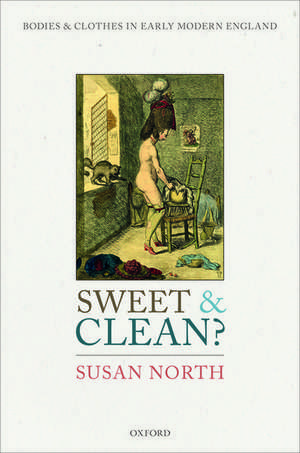Sweet and Clean?: Bodies and Clothes in Early Modern England
Autor Susan Northen Limba Engleză Hardback – 26 mar 2020
Preț: 675.64 lei
Preț vechi: 784.70 lei
-14% Nou
Puncte Express: 1013
Preț estimativ în valută:
129.28€ • 135.34$ • 106.97£
129.28€ • 135.34$ • 106.97£
Carte tipărită la comandă
Livrare economică 26 martie-01 aprilie
Preluare comenzi: 021 569.72.76
Specificații
ISBN-13: 9780198856139
ISBN-10: 019885613X
Pagini: 356
Ilustrații: 46 figures/illustrations
Dimensiuni: 164 x 242 x 26 mm
Greutate: 0.77 kg
Editura: OUP OXFORD
Colecția OUP Oxford
Locul publicării:Oxford, United Kingdom
ISBN-10: 019885613X
Pagini: 356
Ilustrații: 46 figures/illustrations
Dimensiuni: 164 x 242 x 26 mm
Greutate: 0.77 kg
Editura: OUP OXFORD
Colecția OUP Oxford
Locul publicării:Oxford, United Kingdom
Recenzii
This carefully researched and detailed book is important reading, and not just for those with specific interests in dress or textile history, or the history of washing and hygiene. It encourages historians and student historians with broader interests to think about everyday routines and actions in the past, and how we might seek to recover them despite minimal evidence.
Sweet and Clean? provides a detailed reexamination of long-held assumptions about bathing and cleanliness in 16th–18th century England. North, who is curator of fashion at the Victoria & Albert Museum, takes specific aim at the idea that bathing was rare and considered risky, and that changing linen undergarments was the primary method of keeping clean. Summing Up: Highly recommended
What constitutes cleanliness? Or, more relevantly, what constituted personal cleanliness in early modern England? A hint is offered in the cover illustration to Susan North's most recent and thought-provoking book, Sweet and Clean, which depicts James Gillray's 1779 print, The Whore's Last Shift. The woman in question, naked apart from her worn stockings, shoes, and the feathers in her neatly dressed hair, washes her shift in a chamber pot. The use of the pot for washing highlights several things-the desire to have clean linens and, as North notes, a possible reference to the use of the urine in the chamber pot as part of the washing process.
The book is not only a must read for anyone interested in the history of linen and cotton clothing and textiles, but also historians of the body, of cleanliness and of medicine in relation to hygiene and disease.
Sweet and Clean? provides a detailed reexamination of long-held assumptions about bathing and cleanliness in 16th–18th century England. North, who is curator of fashion at the Victoria & Albert Museum, takes specific aim at the idea that bathing was rare and considered risky, and that changing linen undergarments was the primary method of keeping clean. Summing Up: Highly recommended
What constitutes cleanliness? Or, more relevantly, what constituted personal cleanliness in early modern England? A hint is offered in the cover illustration to Susan North's most recent and thought-provoking book, Sweet and Clean, which depicts James Gillray's 1779 print, The Whore's Last Shift. The woman in question, naked apart from her worn stockings, shoes, and the feathers in her neatly dressed hair, washes her shift in a chamber pot. The use of the pot for washing highlights several things-the desire to have clean linens and, as North notes, a possible reference to the use of the urine in the chamber pot as part of the washing process.
The book is not only a must read for anyone interested in the history of linen and cotton clothing and textiles, but also historians of the body, of cleanliness and of medicine in relation to hygiene and disease.
Notă biografică
Susan North is the Curator of Fashion, 1550-1800 at the Victoria and Albert Museum. She has a BA in Art History from Carleton University, Ottawa, an MA in Dress History from the Courtauld Institute, London, and a PhD from Queen Mary, University of London. North worked for the National Gallery of Canada and the National Archives of Canada, before joining the V&A Museum in 1995. She has published articles and book chapters, co-authored several V&A publications relating to early modern dress, as well as co-curating Style and Splendour: Queen Maud of Norway's Wardrobe in 2005 and Splendour of the Tsars in 2008. As a museum curator, North in particularly interested in the material culture of surviving historical clothing, the stories revealed in its materials, methods of construction, and alterations, and how these contribute to broader narratives of early modern history.
